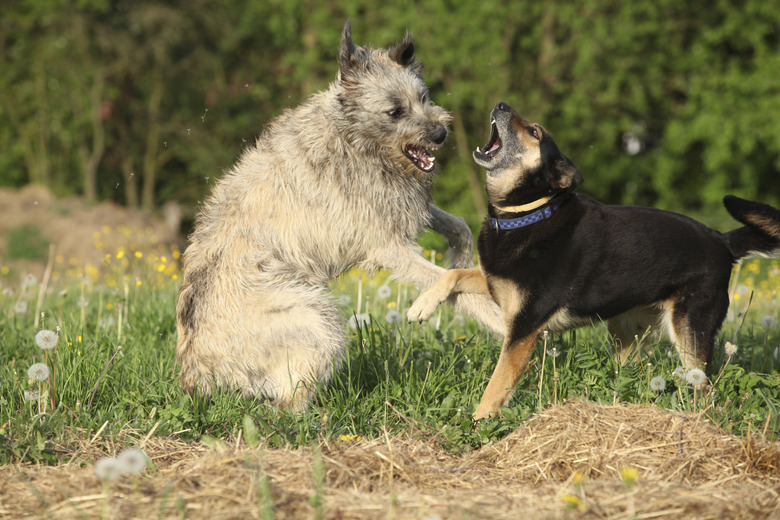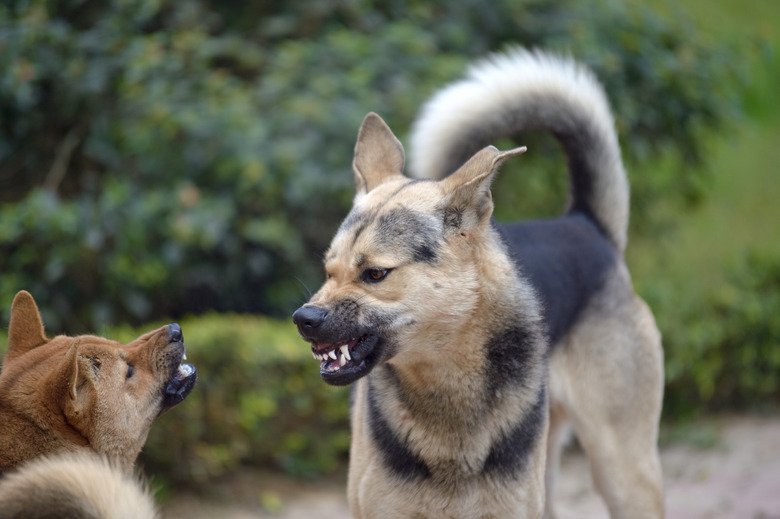How To Help Two Dogs To Get Along When One Is Aggressive
When one dog is aggressive toward another dog with whom it regularly interacts, you'll need to identify the cause before you start trying to correct the behavior. Without knowing why your dog is acting out toward another, your training will be reactive rather than proactive. You can use a few basic steps to figure out how to help dogs get along.
Get in the right mindset
Get
in the right mindset
Before you begin any type of dog training, you need to be in control of your emotions. Your dog will sense if you are nervous, angry, excited, or in any way out of control. You will need to be proactive — not reactive — when the aggressive dog snarls, barks, or charges. This means you need to prepare your response in advance.
Don't yell or raise your hand to intimidate the dog. Your pet will know you're not in control of yourself and therefore the situation. If your dog is acting aggressive, she won't see you as a protector if you're not calm.
Try to identify the cause
Try to
identify the cause
If possible, find out why the one dog is being aggressive toward the other. Causes of aggression can include fear, possessiveness, defensiveness, territoriality, or protectiveness. It can also be sex-related.
Look for patterns. Is the dog only aggressive at feeding time? Does he start to snarl at the other dog when your children are near? What about when the three of you are playing and you are tossing a toy to the other dog? Dogs don't like to share beds, water, food bowls, blankets, or toys. Make sure each pet has his own.
The aggressive dog might be in heat or a new mother protecting her pups. If the passive dog is a recent addition to your family, your aggressive dog might be trying to protect you. If the aggressive dog is a puppy, he might not be socialized, and you just need to get him used to being with other dogs.
Divide and conquer
Divide
and conquer
Try bringing the two dogs together but at a restricted distance. For example, tie up the aggressive dog and play fetch with the other dog. If the aggressive dog starts barking or whining, reassure your pet verbally but don't play with her or pet her. After a short while, tie up the passive dog and play fetch with the aggressive dog. Both dogs will now see that you play with them in the same manner. This might resolve the issue if the aggressive dog was trying to protect you.
Try playing with both dogs together, alternating toys, to see if the aggressive dog allows you to play with the passive dog. If not, firmly (but remaining in control of your emotions) correct him with verbal commands.
You can also try separating the dogs in your home using barriers, such as gates or boxes. You might keep one dog downstairs and the other upstairs. Separate them after an aggressive incident so they know why they are being separated. If the bad behavior you're trying to correct is not constant or frequent, the aggressive dog might not dislike the passive dog. When you separate the dogs, the aggressive pet might become lonely and prefer to behave rather than be separated.
Add some exercise
Add
some exercise
Dogs who lie around all day aren't able to burn excess energy and calories. They are just looking for an excuse to become excited. If you regularly exercise your dog, you might tire her just enough that she won't be aggressive. Talk to your vet about how often and how strenuously your dog should exercise or play.
Try spaying or neutering
Try spaying or neutering
If the aggressive dog is not spayed or neutered, that might be contributing to the problem. Ask your vet if spaying or neutering might solve the issue and if she recommends having the procedure performed. Even if it doesn't solve the problem, spaying and neutering have many positive benefits, so you might have wanted to have the procedure performed anyway.
Contact a dog behavior expert
Contact
a dog behavior expert
If nothing you have tried is working, you might need to call a dog behaviorist. The longer you let the aggression go uncorrected, the more it might become ingrained. The aggressive dog might become the permanent alpha to the other, causing problems for the remainder of their time together.
Start with a phone session (which might be a free consultation) and then set up a time to let the expert meet your pets if he decides that's necessary. Be prepared to show the trainer where aggression normally flares up so he can spot a possible problem. That means that it might be worth the extra fee to have the trainer come to your home rather than visiting his place.

